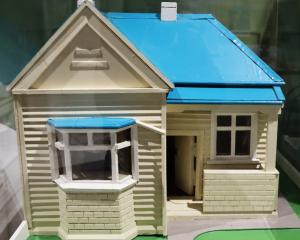
Given a bit of a makeover old chairs still have legs, Gillian Dempster writes.
One form of reuse so common that it has it's own ''re'' prefix is reupholstery.
It's almost impossible to imagine life without comfortable chairs, but upholstered seating was only invented in the 17th century.
Since fabric and springs wear out long before the wooden frames, reupholstery became the way to revive family heirlooms as they're passed down generations.
I love the idea of reupholstering furniture to give it a new life, but it's not cheap to get it done professionally. So when I got the chance to do a weekend reupholstery course with Reg Bartlett, I was so keen that I even gave up a weekend's skiing to do it.
Reg has 40 years of experience in the upholstery trade, and 25 years of tutoring behind him. I figured with his help, my lack of craftiness could be overcome.
Reg advised starting with a simple chair like a kitchen chair, so I took along two brown vinyl chairs that had been left in a house I'd bought many years ago.
The brown vinyl was nasty but the chairs were sturdy and comfortable, and their retro look goes well with our 1970's ex-crib.
I tracked down some vinyl and piping on the internet, and the company sent me a swatch that made choosing a colour much easier.
I emailed Reg a photo of my chairs, and he told me how much vinyl to order. He would have all the extras (such as foam and dacron) available to purchase at the workshop if needed.
My two chrome chairs looked a bit out of place surrounded by antique wooden armchairs and dining chairs at the workshop.
Every chair had a story: most were family heirlooms or had been found in second-hand stores.
There were eight participants in the workshop. You could tell the first-timers as we had brought along complete chairs while the more experienced ladies had already stripped theirs back to the bare bones.
By the end of the first day, I'd unpicked the old vinyl, cut patterns and started sewing the seat covers.
My success caused a rush of blood and I decided to push on and reupholster the whole set of chairs in one weekend.
My kids seized on the chance to take out tacks and staples with screw drivers and pliers in the living room.
With their help, I managed to get all the vinyl unpicked and turned up with an extra four chairs the following morning.
Having put the pressure on myself, the second day I felt like I was on Project Runway. Surrounded by bits of chairs and pieces of vinyl, I sewed as fast as I could, running from one job to another.
About lunch-time I had a terrible moment when I seemed to have made a random pattern which didn't fit any part of the chair.
However, with a bit of help from Reg and my 12-year-old, who turned up for a quick look and ended up on the staple gun for two hours, it all came together. By 4pm, I had a (nearly) finished set of retro chairs which looked better than I had imagined possible.
Some of the other ladies had finished their chairs, while others had made progress on larger projects. The quality of what they had produced was amazing, and it was impossible to tell that it hadn't been done by a professional.
We all experienced the satisfaction of saving a piece of furniture and transforming it into one that adds character and style to our homes.
The only danger is that it opens your eyes to endless possibilities.
I've already signed up for another course to respring my 1960s couch. And I've put aside a chrome rocking chair at Wanaka Wastebusters for a future project.
The only problem will be fitting all my new treasures into my house.
• Gina Dempster is communications officer at Wanaka Wastebusters. Each week in this column, one of a panel of writers addresses issues of sustainability.
Reupholstery
Ten things to know about reupholstery
• The more material you can see, the more work there will be to do. Kitchen and dining chairs are a quick and rewarding place to start.
• No chair or sofa is too old to reupholster. So long as the frame is solid or you can glue it back together, the finished product will make you proud.
• You can get a bargain if you have a good eye. A pair of balloon backed dining chairs reupholstered at our course had been picked up for just $10 each at an Oamaru second-hand shop, but could fetch up to $650 after reupholstering.
• What we think of as antique dining chairs were often made for a formal parlour. People placed upright wooden seats in the lounge in the 18th century, unlike our modern, fully upholstered chairs and sofas. The parlour chairs were more heavily carved and decorated than the dining chairs.
• Online shops make it easy to source upholstery fabric, but make sure you give yourself enough time. Many sellers will send you samples of fabric before you order. For upholstery fabric, try Martha's Furnishings (marthas.co.nz) and Femme de Brocante (fdb.co.nz). For vinyl and outdoor fabric try W. Wiggins (wwiggins.co.nz)
• When you buy from commercial suppliers, check how large their minimum order is. I very nearly bought 25km of red upholstery thread, thinking I was buying a normal cotton reel.
• If you're going to a course, unpick as much as you can before you get there to maximise how much you can get done in the time. Don't throw out the stuffing and covers though, take everything along in case you need it as a pattern or to put back into the chair.
• A surprising amount of stuffing can be reused in the reupholstery process. Usually springs and webbing needed to be replaced, but 100-year-old cotton padding (flock) and flax fibre (tow) can be reused and will do the job just fine.
• The seat of a chair can have as many as seven layers of different materials, starting with webbing and springs, then proceeding through tow, hessian, flock, dacron and finally fabric on top.
• Reupholstering is very manual, and much of the hands-on work can be done by a complete beginner. But to get a professional finish, there are a couple of key moments where expert help is invaluable. The seat cover I put on by myself has a tiny but annoying wrinkle in the corner, the ones Reg helped me put on look absolutely perfect.
Try it
• Reg Bartlett travels around Otago with his reupholstery workshops, which often book out months in advance. Go to Reg's Upholstery Workshops on Facebook for a timetable.












